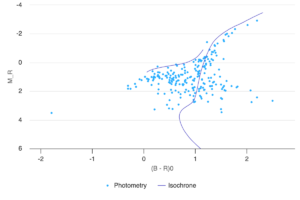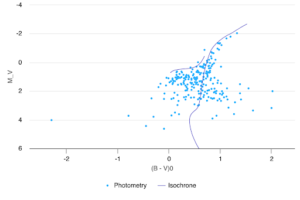IC 4499 is a loose old star cluster in the Southern constellation Apus, with other designations for the globular cluster being GCI 30 and Melotte 129. It was said to be discovered by DeLisle Stewart in Jun 13, 1901, and was thought to be unusual due to the determined metallicity in 1995, made it appear that the star cluster was 3-4 billion years younger than most clusters in the Milky Way
However IC 4499 was re-examined by NASA’s Goddard Space Flight Center in May 18, 2023. Which contradicted the data in 1995, with results that yielded a much older age of 12 billion years for IC 4499. Having roughly the same age as other Milky Way clusters, and like many other very old globular clusters, IC 4499 also contains two generations of stars.
In order to study IC 4499 and investigate the relationships between the colours, brightness, and the age and chemical composition of the cluster as a whole, I collected 15 images in B, V, R filters with the Prompt 6 Telescope from the Skynet Robotic Telescope Network, with total exposure durations of 220.47s, 173,23 and 173.23 in the B, V, R filters respectively and with other imaging parameters, using Skynet.
I used Afterglow to manually colour my star cluster using the multiple B, V, R images I had taken.
| B | V | R |
 |
 |
 |
Combining these filters with the addition of fixing the reddening on the image by using the E (B-V) value data gained through the use of Cluster Astromancer, a combined coloured image is produced.
Using photometry in Afterglow I could get the values in a csv file to use Cluster Astromancer that contains field star removal, archive fetching, and isochrone matching, in order to find data on my star cluster.
By plotting on multiple graphs, I could fine tune my data values to create a more accurate data set.
| BP – RP × RP | B – R × R | J – H × H | B – V × V |
 |
 |
 |
 |
Using the sites above and with the fine tuned graph I was able to retrieve these basic results with a score value of 0.156603 in Astronomicon:
| Name: | IC 4499 |
| Classification: | Globular |
| Star Counts: | 403 |
| Mass: | 1576355,39910147 |
| Physical Radius: | 22.9075888392108 |
| Right Ascension (RA): | 225.07 |
| Declination: | –82.21 |
| Galactic longitude: | 307.356063609781 |
| Galactic latitude: | –20.4697339305103 |
| Angular Radius: | 0.0316365791515588 |
| Proper Motion RA: | 0.47 |
| Proper Motion Declination: | –0.46 |
| Velocity dispersion: | 0.162941824357982 |
| Distance: | 12.72 |
| Log Age: | 10.2 |
| Metallicity: | -1.9 |
| E (B-V): | 0.33 |
This was a school project in the class ASTR 113 2024, where I worked with this cluster during Lab 4.1, 4.2, and the FYRE assignment. I had learned many things studying IC 4499, such as using the site, Skynet to find multiple images of a cluster with B, V, R filters. I had also learnt how to use Afterglow to photometer an image, as well as how to combine the multiple B, V, R images into a single combined coloured image. I also learnt how to use the Cluster Astromancer, learning how to use the field star removal to fine tune my data, as well as archive fetching, and creating graphs and my own data values based on my data using Isochrone matching.
Due to choosing a bright globular cluster, it was quite difficult to understand my images with there being many source of errors in my images. My images were not in sync resulting in a skewed combined coloured image, as well as a huge amount of reddening on my image, making it hard for me to really understand what is happening in it.
IC 4499 was also studied by Kharchenko et al (2013Links to an external site.), who found the parameters:
| Distance: | 18.804 |
| Log Age: | 10.1 |
| Metallicity: | -1.445 |
| E(B-V): | 0.229 |
Plotting this data point in Cluster Astromancer givers me these graphs:
| BP – RP × RP | J – H × H |
 |
 |
Comparing my two graphs it can be determined that visually my graphs are already lacking in precision compared to these data graphs. The distance seems to be largely different from mine, as well as the E (B – V) value. Judging from these graphs alone, it can be understood that Kharchenko has a finer data value set that mine.
Having completed my analysis, I have learned many from this project. This project was an interesting experience and it was quite enjoyable to do, with many of the work done being visible. Overall, this cluster project is definitely memorable and will highly likely to stay in my memories during my lifetime as it was quite fulfilling.
